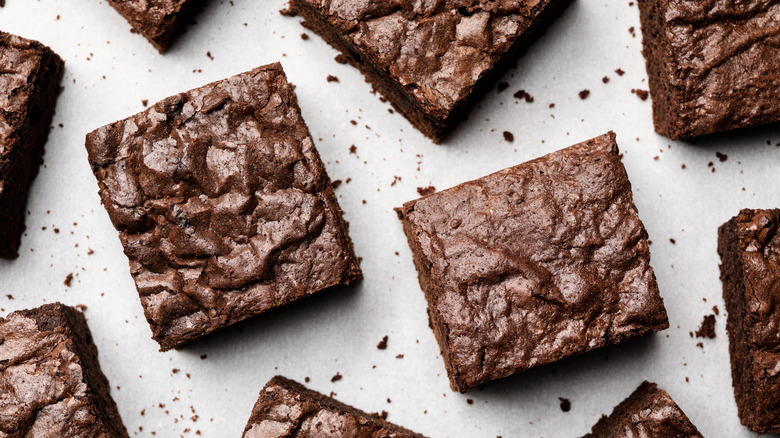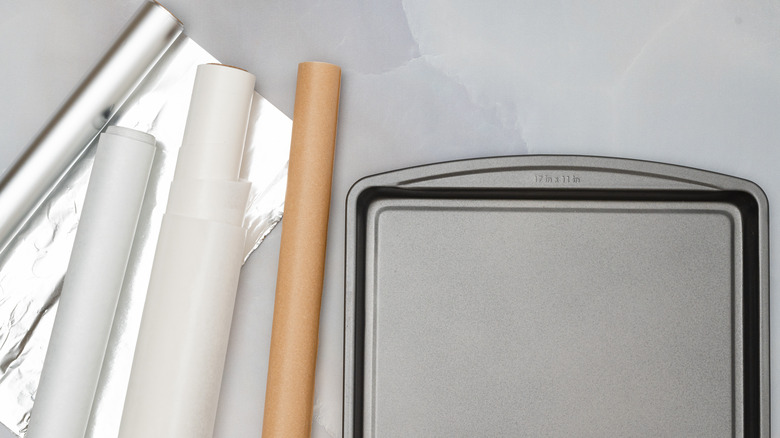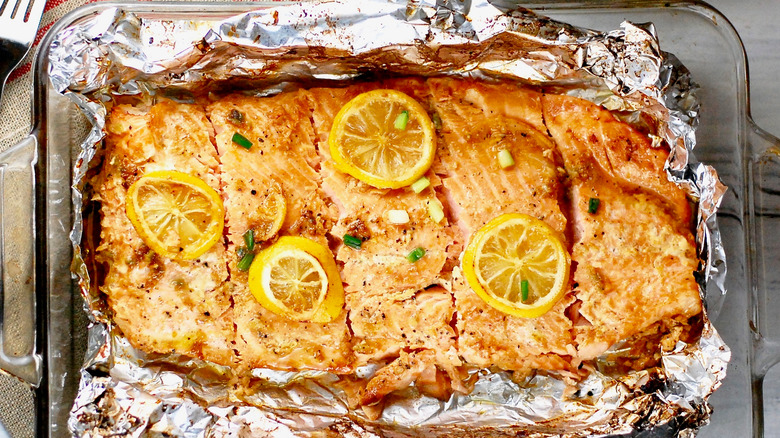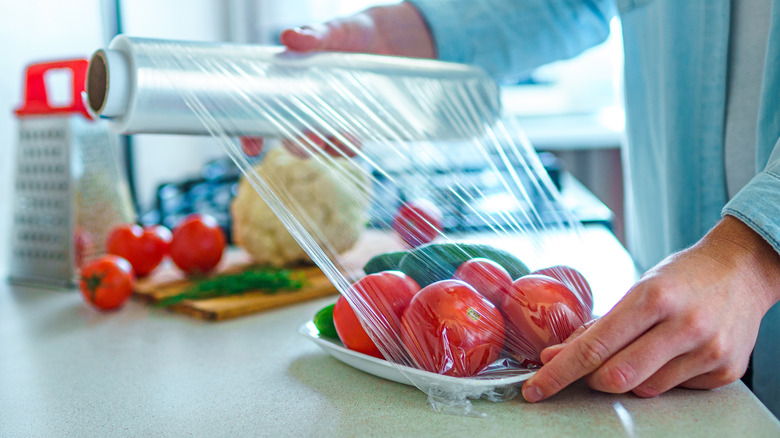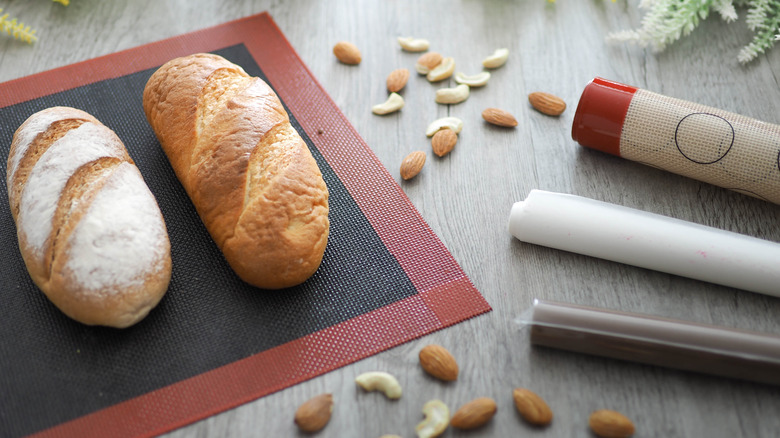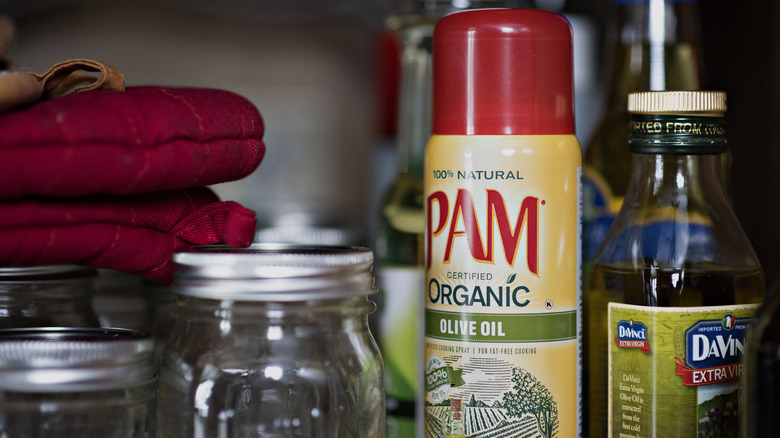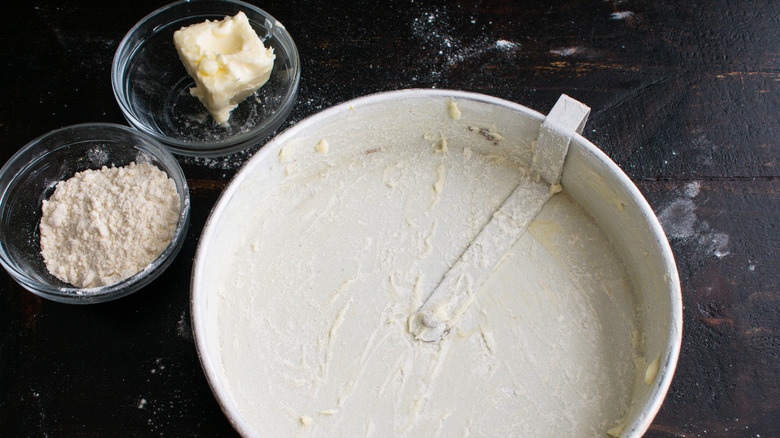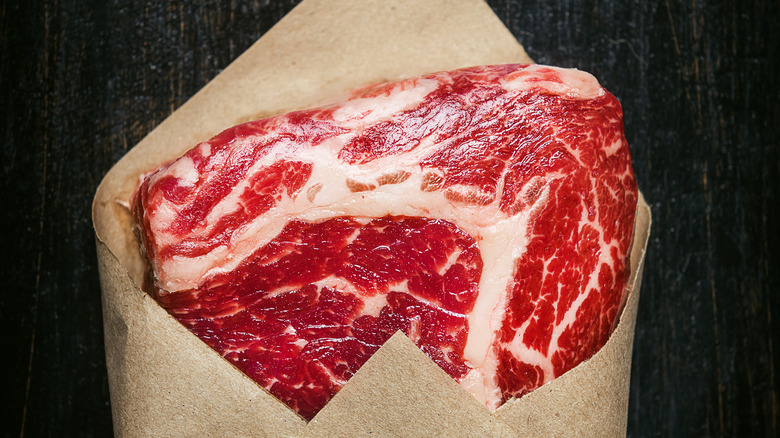7 Best Substitutes For Parchment Paper
From baking to cooking to food prep, parchment paper has so many uses in the kitchen. A quick glance in many pantries will reveal at least one container of this kitchen essential. While some aspiring cooks might use the term generally, parchment paper is actually quite specific. According to the Bob's Red Mill blog, it's described as "paper that has been coated with silicone." Although some people might be wary of silicone touching food, that coating makes the paper "non-stick, heat-resistant, and water-resistant," says the article. And all those elements can be beneficial in both cooking and baking.
While there are both bleached and unbleached versions of parchment paper, the only difference in the two versions is the color; there is no impact on its use, says Southern Living.
Parchment paper can be used in numerous ways, from lining a cookie sheet to using the en Papillote method (cooking a food inside the folded paper). In a pinch, it can even be used to funnel ingredients or help decorate a dessert. The versatility of this item is what makes it a workhorse in the kitchen and can make cleaning up a breeze when using it to line counters.
While many cooks will have a roll of parchment paper in the pantry, sometimes the box runs out. Instead of heading off to the store, though, there are other kitchen essentials that can be a great substitute. Although alternatives have both their benefits and downsides, the reality is that there can be more than one solution — sometimes the answer isn't one sheet fits all.
1. Wax Paper
While the appearance might be similar, there is one major difference between wax paper versus parchment paper. It's all about the heat. Since parchment paper has a silicone coating, it can be used when cooking with heat (via Southern Living). On the other hand, wax paper cannot withstand the same conditions. Just like a candle melts with a flame, the wax paper will wither when exposed to it. When a heat element is removed, however, wax paper can be a great substitute.
Wax paper is often used to keep food from sticking to other items. From wrapping food for freezer storage to lining a counter for rolling cookie dough, the wax paper's non-stick surface is perfect for these tasks. Some other common uses include wrapping sandwiches, lining refrigerator shelves, separating layered desserts in a container, or even funneling dry ingredients into a mixer.
Basically, the substitution factor here just comes down to the temperature issue, which gives you a rubric for when to use wax paper and when to stick to parchment paper.
2. Aluminum Foil
While parchment paper is always nonstick, when it comes to aluminum foil, one thing that's important to understand is that only certain types will have that particular characteristic. Nonstick foil has a special coating, and should be used when making sticky, cheesy, or starchy baked foods. When cooking with nonstick foil, it's also important to remember to use the dull side for placing food on to ensure an easy release.
Standard and heavy duty aluminum foils are not nonstick, but a great trick is to coat them with cooking spray when you need a more slippery surface for things like cheesy potatoes and garlic bread that will be able to pull off from the foil intact.
Since parchment paper isn't suitable for a super hot grill or higher roasting temperatures, aluminum foil is a good choice when cooking over a direct flame. A foil packet works great for cooking proteins, veggies, or shellfish on the grill. As Wide Open Eats notes, this is because aluminum foil does a good job of insulating. Just think about how it is used on a Thanksgiving turkey — the heat and the moisture stay within the sealed area and keep the food flavorful.
Lastly, in a pinch, aluminum foil can be reused — but it should be thrown away if it touches raw food to avoid cross contamination. And, of course, foil should never be put in the microwave unless you are looking for an unlikely science experiment.
3. Plastic Wrap
Even if you always fight the roll, plastic wrap is another great substitution for parchment paper that has many uses in the kitchen. Whether the wrap has a specific brand name or just a general one, the main purpose of this essential cooking tool is to keep food fresh, like sealing leftovers for storage in the refrigerator or keeping bananas from becoming ripe too quickly. Just try not to fight with that clingy wrap as it comes off the roll.
Also, plastic wrap has the major benefit that it can be used in the microwave. Since it can hold up to a quick heating method, it can help to avoid messes, like that loosely covered container of tomato sauce that will inevitably result in big splatters. But, one important tip: Do not let the plastic wrap touch the food as it is cooking. Per MicrowaveMealPrep.com, that's because plastic wrap can melt — unless you want that as an ingredient in your dish.
For a simple guide to know when to use parchment paper versus plastic wrap — here's the key: For quick sealing, storage, and refrigeration, plastic wrap is a great option; for cooking and baking, stick with parchment paper.
4. Silpat
A Silpat — or silicone baking mat — has become a favorite kitchen essential for many bakers and is a great option when you run out of parchment paper. According to Chowhound.com, it's described as a "flexible sheet of food-grade silicone." And that characteristic is key — when choosing a silicone mat, make sure that it says for baking as food-grade options are essential.
It's usable in the freezer and is also usually oven-safe up to 480 degrees Fahrenheit — and it's this versatility that makes a silpat a popular choice. Another reason why bakers choose a silpat is the reusable factor. The ease of using, washing, and re-using again seems like a more environmentally-friendly and cost-effective alternative. In addition, some bakers have found that a silicone baking mat can make cookies spread more. According to HandleTheHeat.com, the slick surface can result in thinner, crispier cookies, sometimes with more browning, if that's what you're going for in your recipe.
When making candies, caramels, or other sticky recipes, Imperial Sugar recommends using a silicone mat here too. The slick surface allows those hot, gooey treats to be kneaded, molded, and otherwise manipulated easily. But, be wary of using sharp objects on a Silpat as tearing or damaging the surface will reduce the non-stick characteristics.
5. Cooking Spray
Since some people find parchment paper expensive, cooking spray can be a lower cost alternative. Even though parchment paper can be used a few times before finding its way to the trash (unless you're cooking with raw food), the ease of spraying a pan and having no waste does appeal to many bakers and cooks. While the spray-and-go method might keep cookies from sticking to the pan, here is a word of caution before taking off the lid.
While it's great to coat the surface of a pan, it can also come as a detriment. Food & Wine suggests having a very clear knowledge of when to use cooking spray and when to not use it — most important is skipping it on non-stick pans. According to the publication, the cooking spray can build up a residue on the surface. And with the abrasive scrubbing required to remove it, the pan could be damaged.
Still, cooking spray is helpful for "sticky cooking" like Rice Krispies treats or even making molasses pour more easily. And, cooking spray can even keep plastic containers from discoloring when applied before putting food inside, according to Good Housekeeping. That's definitely something parchment paper can't do.
6. Butter and Flour
Even though parchment paper is great for lining the bottom of a cake pan, some bakers prefer using the method of butter and flour to grease a pan instead. As shared by Food52, the process can be tedious and time-consuming, but there are particular reasons why this method may be a better choice than ripping offer another sheet of paper.
Greasing a pan with butter and flour does take care. While the purpose is to have the cake easily remove itself from the pan, the reality is that not every time will be perfect. If one spot of the pan isn't covered well, the cake can tear or leave some of its delicate crumb behind.
One of the reasons why bakers prefer the butter and flour method, though, is the golden crust created on the edge of the cake. Anyone who has cut into a bundt cake can appreciate the slight crunch on the outside only to reveal the moist cake waiting to be enjoyed inside.
When deciding between parchment paper and the butter and flour greasing method, the recipe needs to be considered in order to pick the better choice. If the crust is important, butter and flour will be the better option every time.
7. Butcher Paper
During a visit to a favorite barbecue restaurant, one colorful item that might be on the tray or used to serve that big rack of ribs is butcher paper. This type of liner and barbecue are often cooking partners. And, while parchment paper can be used, grill masters often turn to butcher paper for both cooking and serving purposes for good reason.
As shared by GoShindig.com, there is a lengthy discussion on the benefits of using butcher paper on either the smoker or the grill, but the smoker is the more common usage. Since a smoker uses lower heat, the paper will not burn. And, the woodsy flavor can permeate the paper yet it won't over saturate the meat's flavor. Many barbecue fanatics also use butcher paper to wrap the meat for serving. From lining the tray to piling on pieces of brisket to wrapping sausages to keep them moist, there's a variety of key uses.
Although there are many types of butcher paper, most pit masters use the bright pink variety. While all the different colored papers are mostly the same, some people prefer the color for presentation purposes. It can make that rich, well-cooked meat seem even more enticing.
